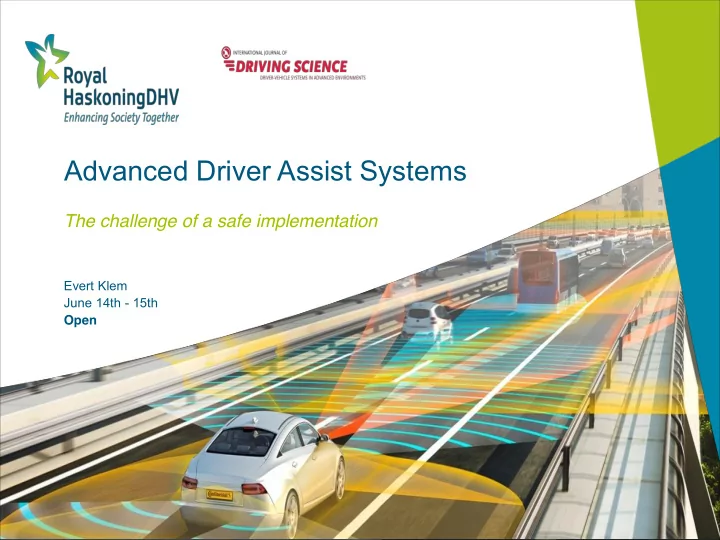

Advanced Driver Assist Systems The challenge of a safe implementation Evert Klem June 14th - 15th Open
Welcome and introduction � Royal HaskoningDHV, international consulting and engineering company � Evert Klem, specialist on Road Safety and Traffic Management � More then 10 projects on (semi-) self driving cars and 5 demonstration projects like Dutch Platooning Test on the highway A2 Some examples: � Implications of self driving cars on road design � Detection of road marking by Lane Keeping Systems � Effect of ACC and C-ACC on road capacity � Effects of (semi) self driving cars on traffic and behaviour � Implications of (semi) self driving cars on drivers training and examination � Public communication of (semi) self driving cars � Research on AEBS at warning systems during road works � 2 June 14th - 15th
Advanced Driver Assist Systems (ADAS) 3 June 14th - 15th
Are you familiar with: Adaptive Cruise Control � Lane Keeping System � Blind Spot Detection � Hazard Recognition � Emergency Break System � Fatigue Warning � Parking Assistance � Cross Traffic Alerts � Auto pilot � 4 June 14th - 15th
How will the next period with a mix of traditional driving and (semi)self-driving vehicles look like? Traditional driving Drivers task In-car developments Now Future 5 June 14th - 15th
Translate future ideas to relevant first steps Developments ? ? Now Future TIME 6 June 14th - 15th
Our first conclusions New in car systems are potential and can improve road safety and traffic flow � Period to come gives possible risks because: � Systems are still developing � We have to deal with mixed traffic (with and without in car systems) � People need to get experienced using these systems � Many questions are not answered yet � Pro active attitude is necessary to prevent accidents to happen � Research of Dutch Safety Board (Onderzoeksraad voor Veiligheid), April 2017 � 7 June 14th - 15th
First research to explore The use of Adaptive Cruise control in practice � The use of Lane keeping Systems � The use of Autonomous Emergency Breaking Systems � Goal: � Get more facts and figures how these systems are used, � How the really act in practice � What the effect is on road safety and traffic flow � How we can improve use and effect � 8 June 14th - 15th
Lane keeping System (LKS) Method: � 4 cars equipped with double camera’s (on the Road and on the dashboard) � Collecting data during 4 weeks in normal traffic (no extra risks), with different � weather and light conditions. Analysing video’s and data of the motor management system � Results are indicative � Survey on 100 users of ACC � 9 June 14th - 15th
Lane Assist 10 June 14th - 15th
Design of research 11 June 14th - 15th
Map of invested roads 12 June 14th - 15th
Field test - Parameters Road type � Type of marking � Age of asphalt and marking � Public lights � Trees near the road � Time of the day � Weather conditions � 13 June 14th - 15th
Field test – Material, age and conditions Material Age Leng Daylight, Daylight, Night, Night, th Dry (11 Wet (3 Dry (4 Wet (3 (km) times) times) times) times) Spetter 0-3 year 11,9 99,3% 94,4% 99,8% 84,4% marking 3+ year 8,9 90,8% 96,3% 94,9% 77,9% Thermoplast 0-3 year 15,2 92,6% 99,1% 100% 79,3% 3+ year 32,8 95,5% 94,4% 100% 84,7% 14 June 14th - 15th
Field test – Wet surface 15 June 14th - 15th
Field test – Public lights Percentage of marking recognized Night, dry Night, wet With public lights Without public lights 16 June 14th - 15th
Field test – Public lights 17 June 14th - 15th
Field test - Trees Day light 18 June 14th - 15th
Field test – Trees 19 June 14th - 15th
Field test – Cycle lanes 20 June 14th - 15th
Survey - Information Searched for system information Was informed about the system 21 June 14th - 15th
Survey – Perception of safety Feels safer with LKS activated Feels safer with LDWS activated 22 June 14th - 15th
Conclusions Survey: Information by car sellers is poor � Most users learn to use systems by doing in practice � Field test: Best performance at night under dry conditions � Effect of sunlight (opposite lights and influence of shadows) � Rain and wet surfaces causes reflection � Public lights has negative influence on visibility of marking at night. � Trees cause dirt and shadow – less visibility � System has higher risks at ETW-marking / cycle lanes � 23 June 14th - 15th
Recommendations Human factors: � Information and instruction before use but also during training and examination � Vehicle: � Improve LDWS and LKS systems, especially sensors � � Infrastructure: Change marking on ETW � Improve drainage along the road � Prevent bushes along the road � Keep the road and marking clean � Improve quality of road marking? � 24 June 14th - 15th
Exposure in Dutch media 25 June 14th - 15th
Thank you for your attention Questions and Discussion 26 June 14th - 15th
Recommend
More recommend